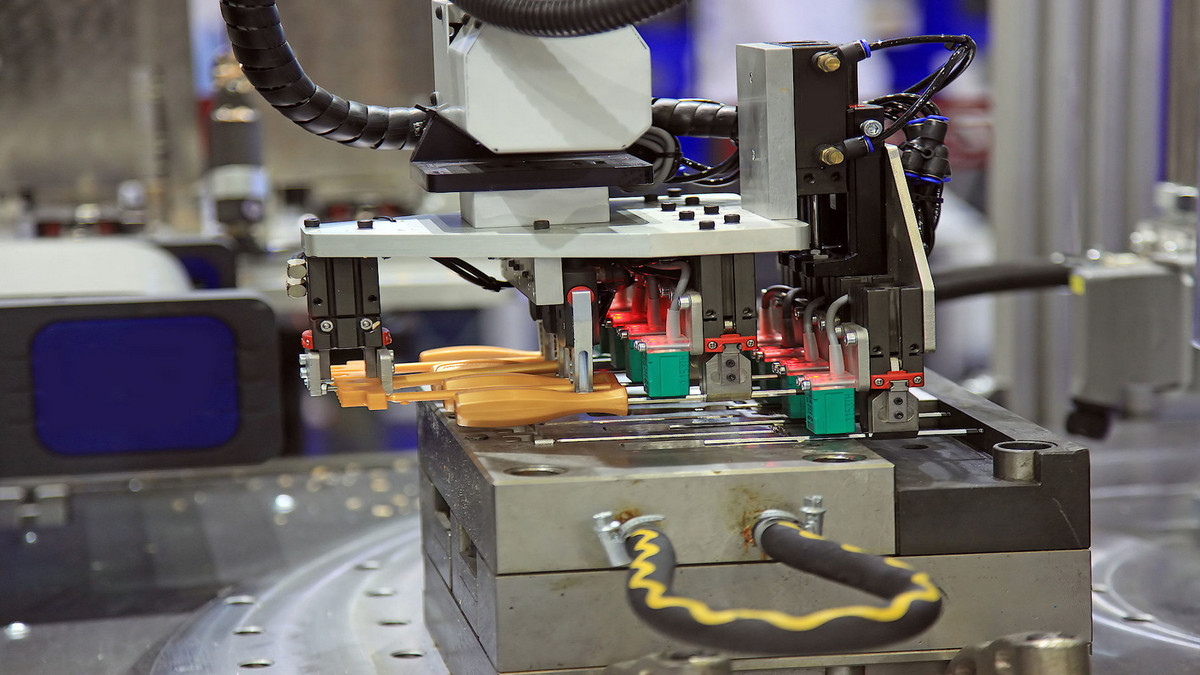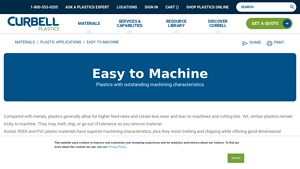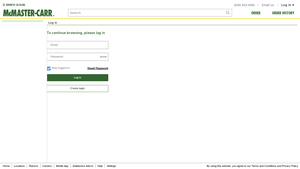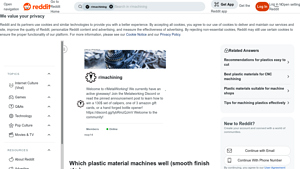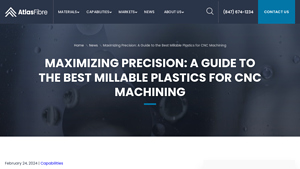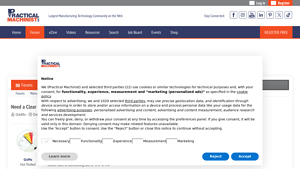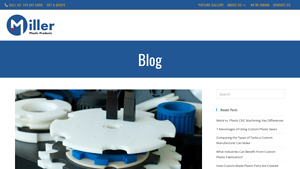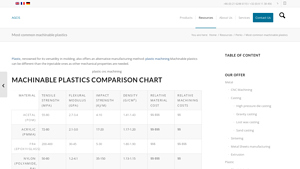Machinable Plastic Guide: Type, Cost, Top List…
Introduction: Navigating the Global Market for machinable plastic
In the ever-evolving landscape of global manufacturing, sourcing machinable plastics presents unique challenges for B2B buyers across diverse industries. Whether you’re an engineer in Germany seeking high-performance materials for aerospace applications or a manufacturer in Nigeria looking for cost-effective solutions for prototyping, understanding the nuances of machinable plastics is crucial. This guide delves into the intricacies of sourcing and utilizing machinable plastics, equipping you with the knowledge to make informed purchasing decisions.
From exploring various types of machinable plastics—such as PEEK, Acetal, and Polycarbonate—to understanding their specific applications in fields like automotive, medical, and aerospace, this comprehensive resource covers it all. Buyers will benefit from insights on supplier vetting, ensuring that you choose partners who meet quality and performance standards. Additionally, we address cost considerations, helping you balance budget constraints with the need for quality materials.
By empowering international B2B buyers, particularly from Africa, South America, the Middle East, and Europe, this guide aims to streamline your procurement process. With actionable insights and a focus on optimizing performance and durability, you’ll be better positioned to navigate the complexities of the global market for machinable plastics, ultimately enhancing your operational efficiency and product innovation.
Understanding machinable plastic Types and Variations
| Type Name | Key Distinguishing Features | Primary B2B Applications | Brief Pros & Cons for Buyers |
|---|---|---|---|
| PEEK | High temperature resistance, chemical stability | Aerospace, automotive, medical | Pros: Excellent durability, lightweight; Cons: Higher cost compared to other plastics. |
| Acetal | Low friction, high strength, good wear resistance | Precision machining, automotive | Pros: Cost-effective, easy to machine; Cons: Limited temperature resistance. |
| Polycarbonate | High impact strength, optical clarity | Electronics, safety equipment | Pros: Lightweight, excellent toughness; Cons: Susceptible to scratching. |
| Nylon | Strong, tough, good dimensional stability | Bearings, gears, automotive parts | Pros: Versatile, good wear properties; Cons: Can absorb moisture, affecting dimensions. |
| HDPE | Chemical resistance, low density | Packaging, piping, containers | Pros: Affordable, easy to fabricate; Cons: Lower strength compared to other engineering plastics. |
What Are the Key Characteristics of PEEK and Its Suitability for B2B Buyers?
PEEK (Polyether Ether Ketone) is recognized for its exceptional thermal and chemical resistance, making it ideal for demanding applications in industries such as aerospace and medical. Its ability to maintain mechanical properties at elevated temperatures enhances its suitability for high-performance components. B2B buyers should consider PEEK for applications requiring durability and reliability, despite its higher price point, which may be justified by its long-term performance and lower maintenance costs.
Why Choose Acetal for Precision Machining Applications?
Acetal, known for its low friction and high strength, is an excellent choice for precision machining. It is easy to machine and offers good wear resistance, making it suitable for applications like automotive components and gears. B2B buyers should weigh its cost-effectiveness against its limitations, such as moderate temperature resistance, to determine its fit for their specific projects.
How Does Polycarbonate Stand Out in the Market?
Polycarbonate is distinguished by its high impact strength and optical clarity, making it a preferred choice for applications in electronics and safety equipment. Its lightweight nature combined with toughness makes it an attractive option for manufacturers. However, B2B buyers should be mindful of its susceptibility to scratches, which may necessitate additional protective measures in certain applications.
What Advantages Does Nylon Offer for Engineering Applications?
Nylon is a versatile engineering plastic known for its strength and dimensional stability. It excels in applications like bearings and gears due to its excellent wear properties. While its ability to absorb moisture can affect its dimensions, B2B buyers can mitigate this by selecting appropriate grades and considering environmental conditions during application.
Why Is HDPE a Popular Choice for Various Industries?
HDPE (High-Density Polyethylene) is celebrated for its affordability and ease of fabrication. Its chemical resistance makes it suitable for a wide range of applications, including packaging and piping. B2B buyers should consider HDPE for projects where cost is a major factor, while also being aware of its lower strength compared to other engineering plastics, which may limit its use in high-stress applications.
Key Industrial Applications of machinable plastic
| Industry/Sector | Specific Application of machinable plastic | Value/Benefit for the Business | Key Sourcing Considerations for this Application |
|---|---|---|---|
| Aerospace | Components for aircraft interiors and exteriors | Weight reduction, corrosion resistance, and durability | Certifications, material performance data, lead times |
| Medical Devices | Surgical instruments and housings | Biocompatibility, precision, and ease of sterilization | Regulatory compliance, material certifications, sourcing from reputable suppliers |
| Automotive | Engine components and interior parts | Improved fuel efficiency, reduced weight, and cost savings | Material specifications, performance testing, global supply chain logistics |
| Electronics | Insulating components and housings | Enhanced electrical insulation, durability, and reduced weight | Material grades, compliance with electrical standards, availability in local markets |
| Food Processing | Conveyor components and equipment parts | Resistance to chemicals, ease of cleaning, and durability | FDA compliance, material certifications, sourcing local suppliers for quick delivery |
How is Machinable Plastic Used in Aerospace Applications?
In the aerospace industry, machinable plastics are utilized for both interior and exterior components, such as cabin fittings and fairings. These materials, like PEEK and polycarbonate, significantly reduce weight compared to traditional metals, enhancing fuel efficiency. Additionally, their resistance to corrosion and environmental stressors ensures longevity and reliability. For international buyers, particularly in Europe and the Middle East, sourcing materials that meet stringent aerospace standards and certifications is crucial to avoid compliance issues.
What Role Does Machinable Plastic Play in Medical Devices?
Machinable plastics are essential in the medical device sector, where they are used for surgical instruments, housings, and various components. Materials such as acetal and polycarbonate are favored for their biocompatibility, precision, and ability to withstand sterilization processes. For B2B buyers in regions like Africa and South America, ensuring that sourced materials comply with medical regulations and certifications is vital for market entry and product safety.
How is Machinable Plastic Beneficial in the Automotive Industry?
In automotive applications, machinable plastics are employed for engine components, dashboards, and interior fittings. These materials help reduce overall vehicle weight, which directly contributes to improved fuel efficiency and lower emissions. For businesses in Europe and Africa, it is essential to focus on sourcing plastics that meet automotive industry standards and specifications, ensuring reliability and performance in diverse environmental conditions.
What Are the Advantages of Machinable Plastics in Electronics?
Machinable plastics serve a critical role in the electronics industry, where they are used for insulating components, housings, and circuit boards. Their excellent electrical insulation properties and lightweight nature provide significant advantages over metals. For international buyers, particularly in South America and Nigeria, it is important to source materials that comply with global electrical standards and offer reliable performance in various applications.
How Do Machinable Plastics Enhance Food Processing Equipment?
In the food processing sector, machinable plastics are utilized for conveyor components and equipment parts that require high durability and resistance to chemicals. Materials like HDPE and PTFE are particularly valued for their ease of cleaning and compliance with food safety regulations. B2B buyers in the Middle East and Africa should prioritize sourcing FDA-compliant materials to ensure that their products meet local and international food safety standards.
3 Common User Pain Points for ‘machinable plastic’ & Their Solutions
Scenario 1: Difficulty in Achieving Precision During Machining
The Problem: Many B2B buyers in the manufacturing sector struggle with the precision required when machining machinable plastics. Factors such as thermal expansion, improper tool selection, and inadequate machining parameters can lead to dimensional inaccuracies, resulting in parts that do not meet specifications. This issue is particularly pronounced with materials like PEEK or Acetal, which, while excellent in terms of performance, can be sensitive to the heat generated during machining. Buyers often find themselves facing costly rework or scrap due to parts that are out of tolerance, which can significantly impact production timelines and budgets.
The Solution: To overcome precision challenges, B2B buyers should focus on optimizing their machining parameters. This includes selecting the right cutting tools and speeds tailored to the specific machinable plastic being used. For instance, utilizing carbide tools can provide better wear resistance and precision. Additionally, implementing cooling techniques—such as using mist or flood coolant—can help manage heat and prevent warping. Buyers should also consider pre-machining annealing for thermoplastics, which can enhance dimensional stability. Collaborating closely with suppliers to understand the material properties and gaining insights on best machining practices can also lead to improved outcomes.
Scenario 2: Material Selection Confusion
The Problem: With a wide variety of machinable plastics available, B2B buyers often find it challenging to select the right material for their specific application. Each type of plastic, whether it be Nylon, Polycarbonate, or HDPE, has distinct mechanical properties, chemical resistances, and machining characteristics. This confusion can result in choosing an unsuitable material, leading to failures in performance and increased costs associated with testing and validation.
The Solution: To streamline material selection, B2B buyers should establish a clear understanding of their project requirements—such as load-bearing capacity, environmental exposure, and thermal stability. Developing a checklist that outlines the critical properties needed for the application can help narrow down the options. Furthermore, leveraging the expertise of suppliers or industry specialists can provide valuable insights into material performance under various conditions. Conducting small-scale prototyping with selected materials can also allow buyers to test their choices before full-scale production, minimizing the risks associated with incorrect material selection.
Scenario 3: Challenges with Post-Machining Finishing Processes
The Problem: After machining, many B2B buyers encounter issues related to the finishing processes of machinable plastics, such as sanding, polishing, or coating. Certain plastics can be difficult to finish due to their inherent properties, leading to problems like surface imperfections or inadequate bonding with coatings. This is particularly true for materials like Acrylic or Polycarbonate, where clarity and aesthetics are crucial, especially in industries like automotive or consumer products.
The Solution: To address finishing challenges, buyers should adopt a systematic approach that includes selecting appropriate finishing techniques based on the specific plastic type. For instance, using finer grit sandpaper can help achieve a smoother finish on Acrylic, while specific polishing compounds can enhance clarity. Additionally, understanding the chemical compatibility of coatings with the plastic can prevent issues like peeling or bubbling. Buyers should also invest in training for their workforce on the best practices for finishing techniques specific to the materials being used. Consulting with suppliers for recommendations on compatible finishing products can further enhance the final product’s quality and appearance.
Strategic Material Selection Guide for machinable plastic
What Are the Key Properties of PEEK in Machinable Plastic Applications?
PEEK (Polyether Ether Ketone) is a high-performance thermoplastic known for its exceptional mechanical and thermal properties. It boasts a continuous service temperature of up to 260°C (500°F) and maintains its strength under high pressure. PEEK is also highly resistant to a wide range of chemicals, making it suitable for demanding environments such as aerospace, automotive, and medical applications. Its low friction characteristics and dimensional stability further enhance its performance in precision machining.
Pros and Cons of PEEK for B2B Buyers
The advantages of PEEK include its high durability, resistance to wear, and ability to withstand extreme temperatures, which make it ideal for long-lasting components. However, PEEK is one of the more expensive machinable plastics, which can be a barrier for cost-sensitive projects. Additionally, its machining complexity requires specialized tools and techniques, potentially increasing manufacturing lead times.
Impact on Application and Considerations for International Buyers
PEEK’s compatibility with harsh media, such as solvents and high-temperature fluids, makes it a preferred choice in industries like oil and gas. For international buyers, especially in regions like Europe and the Middle East, compliance with standards such as ASTM and ISO is critical, as these materials often undergo rigorous testing to ensure quality and safety.
How Does Acetal Compare as a Machinable Plastic?
Acetal, also known as polyoxymethylene (POM), is another popular choice for machinable plastics due to its excellent mechanical properties and ease of machining. It exhibits good dimensional stability and low friction, making it suitable for applications requiring precision, such as gears and bearings. Acetal can withstand temperatures up to 100°C (212°F) and is resistant to moisture and many chemicals.
Pros and Cons of Acetal
The primary advantages of Acetal include its cost-effectiveness and outstanding machinability, which allows for high feed rates and reduced tool wear. However, it can be prone to environmental stress cracking, particularly when exposed to certain chemicals, which may limit its application in specific industries.
Impact on Application and Considerations for International Buyers
Acetal is commonly used in automotive and consumer goods applications. For international buyers, especially from Africa and South America, understanding local regulations regarding chemical resistance and environmental impact is essential, as these factors can influence material selection.
What Makes Polycarbonate a Viable Option for Machinable Plastics?
Polycarbonate is a transparent thermoplastic known for its high impact resistance and optical clarity. It can withstand temperatures up to 120°C (248°F) and is often used in applications requiring transparency, such as safety goggles and protective shields. Polycarbonate also has good dimensional stability and can be easily machined into complex shapes.
Pros and Cons of Polycarbonate
The advantages of polycarbonate include its excellent toughness and ability to withstand high-impact forces, making it ideal for protective applications. However, it can be more susceptible to scratching and UV degradation compared to other materials, which may necessitate additional coatings or treatments.
Impact on Application and Considerations for International Buyers
Polycarbonate’s applications span industries from healthcare to automotive. International buyers must consider compliance with safety standards, particularly in Europe, where regulations on optical clarity and impact resistance are stringent.
How Does HDPE Stand Out in the Machinable Plastic Market?
High-Density Polyethylene (HDPE) is a versatile and cost-effective machinable plastic known for its excellent chemical resistance and low moisture absorption. It can handle temperatures up to 120°C (248°F) and is often used in applications like containers, piping, and automotive parts.
Pros and Cons of HDPE
The key advantages of HDPE include its durability, lightweight nature, and resistance to a wide range of chemicals, making it suitable for various applications. However, its lower temperature resistance compared to other plastics like PEEK may limit its use in high-temperature environments.
Impact on Application and Considerations for International Buyers
HDPE is widely used in packaging and construction. For buyers in Africa and South America, the material’s recyclability and compliance with local environmental regulations can be significant selling points.
Summary Table of Machinable Plastics
| Material | Typical Use Case for machinable plastic | Key Advantage | Key Disadvantage/Limitation | Relative Cost (Low/Med/High) |
|---|---|---|---|---|
| PEEK | Aerospace, automotive, medical components | High thermal and chemical resistance | High cost and complex machining | High |
| Acetal | Gears, bearings, consumer goods | Excellent machinability and cost-effective | Prone to environmental stress cracking | Medium |
| Polycarbonate | Safety goggles, protective shields | High impact resistance and optical clarity | Susceptible to scratching and UV degradation | Medium |
| HDPE | Containers, piping, automotive parts | Durable and chemically resistant | Lower temperature resistance | Low |
In-depth Look: Manufacturing Processes and Quality Assurance for machinable plastic
What Are the Key Stages in the Manufacturing Process of Machinable Plastics?
The manufacturing of machinable plastics involves several critical stages that ensure the final product meets industry standards and customer specifications. Understanding these stages is essential for B2B buyers who require precision-engineered components.
Material Preparation: How Is the Right Plastic Selected and Prepared?
Material preparation is the first step in the manufacturing process. It begins with selecting the appropriate machinable plastic based on the specific application requirements. Popular choices include PEEK, Acetal, and Polycarbonate, known for their outstanding mechanical properties and machinability.
Once the material is selected, it undergoes a thorough inspection to verify its quality and suitability. This may include checking for impurities, moisture content, and dimensional consistency. After inspection, the material is cut into manageable sizes, often in the form of sheets, rods, or blocks, which can be easily handled during subsequent stages.
What Techniques Are Used for Forming Machinable Plastics?
Forming is the next stage, where the prepared plastic is shaped into desired forms through various techniques. Common methods include:
-
CNC Machining: This is the most prevalent technique for creating precision parts. Computer Numerical Control (CNC) machines utilize cutting tools to remove material and achieve exact dimensions. The process is suitable for both simple and complex geometries.
-
Injection Molding: For large production runs, injection molding is often employed. This method involves melting the plastic and injecting it into molds to form components. While this technique is efficient for high-volume production, it requires significant upfront investment in mold design.
-
Thermoforming: This technique involves heating plastic sheets until pliable and then forming them over molds. It’s particularly useful for creating larger parts with uniform thickness.
-
Extrusion: This is used for creating continuous profiles, such as tubes or sheets. The plastic is forced through a die to achieve the desired cross-section.
Each method has its advantages and is selected based on factors such as the complexity of the part, production volume, and material properties.
How Is Assembly Performed on Machinable Plastics?
After forming, assembly may be necessary, especially for multi-part products. Assembly techniques can include:
- Adhesive Bonding: Using specialized adhesives to join parts, particularly when mechanical fasteners are not feasible.
- Mechanical Fastening: Utilizing screws, bolts, or clips to assemble components.
- Welding: In some cases, plastics can be welded using heat or ultrasonic methods for strong, permanent joints.
Choosing the right assembly method is crucial for ensuring the integrity and performance of the final product.
What Finishing Processes Enhance the Quality of Machinable Plastics?
Finishing processes improve the aesthetic and functional properties of machined plastics. Common finishing techniques include:
- Surface Treatment: Techniques such as sanding, polishing, or bead blasting to enhance surface finish and reduce friction.
- Coating: Applying protective coatings can improve chemical resistance and durability.
- Engraving: This adds branding or identification marks, often necessary for B2B applications.
These finishing touches not only improve the appearance of the products but also enhance their performance characteristics, making them suitable for their intended use.
What Quality Assurance Measures Are Essential for Machinable Plastics?
Quality assurance (QA) is a crucial component of the manufacturing process, ensuring that products meet established standards and customer expectations. For B2B buyers, understanding the QA measures in place can significantly influence purchasing decisions.
Which International Standards Should B2B Buyers Consider?
International standards such as ISO 9001 are pivotal in establishing a framework for quality management systems. Compliance with these standards ensures that suppliers maintain consistent quality throughout the manufacturing process. Additionally, specific industries may have their own standards, such as:
- CE Marking: Indicates compliance with European health, safety, and environmental protection standards.
- API Standards: Relevant for components used in the oil and gas industry.
B2B buyers should prioritize suppliers that adhere to these standards, as they reflect a commitment to quality.
What Are the Key Quality Control Checkpoints in Manufacturing?
Quality control (QC) is embedded at various stages of the manufacturing process. Key checkpoints include:
-
Incoming Quality Control (IQC): This initial stage assesses the quality of raw materials before they enter production. It includes testing for material specifications and physical properties.
-
In-Process Quality Control (IPQC): During manufacturing, ongoing checks are performed to monitor processes and detect any deviations. This may involve measuring dimensions, checking for defects, and ensuring that machinery operates within specified parameters.
-
Final Quality Control (FQC): Once manufacturing is complete, a final inspection verifies that the product meets all specifications. This may involve functional testing, dimensional checks, and aesthetic evaluations.
What Testing Methods Are Commonly Used for Machinable Plastics?
Common testing methods for machinable plastics include:
- Mechanical Testing: Assessing tensile strength, impact resistance, and hardness to ensure the material can withstand operational demands.
- Thermal Testing: Evaluating the performance of plastics under varying temperature conditions to confirm stability and performance.
- Chemical Resistance Testing: Ensuring that the materials can withstand exposure to various chemicals relevant to their intended application.
These tests provide tangible evidence of a product’s performance capabilities, which is critical for B2B buyers.
How Can B2B Buyers Verify Supplier Quality Assurance?
To ensure that suppliers adhere to quality standards, B2B buyers should implement the following verification strategies:
- Supplier Audits: Conducting regular audits of suppliers to assess their compliance with quality standards and processes. This may include reviewing documentation, inspecting facilities, and interviewing personnel.
- Quality Reports: Requesting detailed quality reports from suppliers that outline their QC processes, results from testing, and any corrective actions taken.
- Third-Party Inspections: Engaging independent third-party inspectors to evaluate products before shipment. This provides an unbiased assessment of quality and compliance.
What Are the Nuances in QC and Certification for International B2B Buyers?
International buyers, particularly from regions like Africa, South America, the Middle East, and Europe, must be aware of the nuances in quality certification. Different regions may have specific regulatory requirements, and understanding these can aid in compliance and avoid costly delays.
For example, while CE marking is crucial for products sold in Europe, other regions may require different certifications. It is essential for buyers to communicate clearly with suppliers regarding these requirements and to ensure that all necessary documentation is provided.
In conclusion, understanding the manufacturing processes and quality assurance measures for machinable plastics is vital for B2B buyers. By focusing on these areas, companies can ensure they procure high-quality materials that meet their operational needs and industry standards.
Practical Sourcing Guide: A Step-by-Step Checklist for ‘machinable plastic’
Introduction
This practical sourcing guide is designed to assist B2B buyers in the procurement of machinable plastics. Understanding the right materials, suppliers, and processes is crucial to ensure optimal performance and cost-effectiveness in your projects. Follow these steps to streamline your sourcing process and make informed decisions.
Step 1: Define Your Technical Specifications
Before beginning your search, clearly outline your technical requirements for the machinable plastic. This includes factors such as mechanical properties, chemical resistance, and thermal stability.
– Consider the application: Different industries may require specific attributes; for example, aerospace components may need high-temperature resistance, while medical devices may prioritize biocompatibility.
Step 2: Research Available Machinable Plastics
Familiarize yourself with the types of machinable plastics available in the market. Common options include PEEK, Acetal, Nylon, and Polycarbonate, each with unique machining characteristics and benefits.
– Evaluate their properties: Assess factors like impact strength, wear resistance, and dimensional stability to determine which materials meet your needs.
Step 3: Evaluate Potential Suppliers
Thoroughly vet potential suppliers before making any commitments. Request company profiles, certifications, and case studies to gauge their reliability and expertise in providing machinable plastics.
– Check references: Reach out to current or past clients in similar industries or regions to understand their experiences and satisfaction levels with the supplier.
Step 4: Verify Certifications and Compliance
Ensure that your suppliers hold the necessary certifications and comply with relevant industry standards. This may include ISO certifications or compliance with regional regulations, particularly if you are sourcing from international suppliers.
– Assess quality assurance processes: Inquire about their manufacturing practices and quality control measures to ensure consistency and reliability in the products you purchase.
Step 5: Request Samples and Conduct Testing
Before finalizing your order, request samples of the machinable plastic to evaluate its performance in real-world applications. Conduct tests that mimic the conditions your end product will face.
– Examine machining characteristics: Assess factors like ease of machining, dimensional accuracy, and surface finish to ensure the material meets your quality expectations.
Step 6: Negotiate Terms and Pricing
Once you have identified a suitable supplier, engage in discussions regarding pricing, lead times, and payment terms. This is a critical step to ensure that your procurement process aligns with your budget and project timelines.
– Consider bulk purchasing: If you anticipate ongoing needs, negotiating bulk pricing can lead to significant cost savings over time.
Step 7: Establish a Long-Term Relationship
After your initial purchase, focus on building a long-term relationship with your supplier. Regular communication and feedback can enhance collaboration and ensure that your future sourcing needs are met effectively.
– Encourage innovation: Discuss potential improvements and new materials that could benefit your projects, fostering a partnership that evolves with your business requirements.
By following this step-by-step checklist, B2B buyers can effectively navigate the sourcing process for machinable plastics, ensuring they select the right materials and suppliers to support their operational needs.
Comprehensive Cost and Pricing Analysis for machinable plastic Sourcing
What Are the Key Cost Components for Machinable Plastic Sourcing?
When sourcing machinable plastics, understanding the underlying cost structure is crucial for B2B buyers. The total cost typically encompasses several components:
-
Materials: The choice of plastic significantly influences costs. Common machinable plastics like PEEK, Acetal, and Nylon can vary greatly in price due to their properties and applications. High-performance plastics generally command higher prices due to their specialized characteristics.
-
Labor: Labor costs are influenced by the complexity of the machining process. Skilled labor is often required for precision machining, especially when working with tougher materials. This can vary by region; for instance, labor costs in Europe may be higher than in parts of Africa or South America.
-
Manufacturing Overhead: This includes costs associated with facilities, utilities, and indirect labor. Manufacturing overhead can vary based on the location of production and the scale of operations.
-
Tooling: Tooling costs involve the initial investment in cutting tools and molds specific to the machinable plastics being processed. These costs can be amortized over larger production runs, making bulk orders more cost-effective.
-
Quality Control (QC): Ensuring the end products meet specifications requires investment in QC processes. Certifications, especially for industries like aerospace or medical, can add to costs but are essential for compliance.
-
Logistics: Transportation costs, including shipping and handling, can vary significantly based on the distance from the supplier and the chosen Incoterms. Costs can be higher for international shipments due to tariffs and customs duties.
-
Margin: Suppliers typically build a profit margin into their pricing, which can vary based on market demand, competitive landscape, and supplier reputation.
How Do Price Influencers Affect Machinable Plastic Costs?
Several factors can influence the pricing of machinable plastics:
-
Volume/MOQ: Suppliers often provide discounts for larger orders. Minimum Order Quantities (MOQ) can restrict small buyers, but negotiating for lower MOQs can yield better pricing.
-
Specifications and Customization: Custom specifications, such as unique dimensions or tolerances, can drive up costs. Standardized parts typically have lower pricing due to economies of scale.
-
Material Selection: The properties required for the application can influence material choice, impacting costs. For example, while PEEK offers superior performance, it is more expensive than materials like HDPE.
-
Quality and Certifications: Products requiring specific certifications (e.g., ISO, FDA) will often be priced higher due to the additional processes involved in achieving compliance.
-
Supplier Factors: The reputation and reliability of the supplier can affect pricing. Established suppliers may charge more for their assurance of quality and timely delivery.
-
Incoterms: The chosen Incoterms can greatly influence total costs by determining who bears the shipping costs and risks. Understanding these terms is essential for budgeting.
What Negotiation Strategies Can Enhance Cost-Efficiency?
B2B buyers can implement several strategies to optimize their sourcing costs:
-
Leverage Relationships: Building a strong relationship with suppliers can lead to better pricing and terms. Regular communication and transparency about needs can facilitate negotiations.
-
Evaluate Total Cost of Ownership (TCO): Instead of focusing solely on the initial purchase price, consider the TCO, which includes maintenance, operational costs, and lifespan of the material. This approach can lead to more informed purchasing decisions.
-
Benchmark Pricing: Researching market prices for similar materials and services can provide leverage in negotiations. Understanding the competitive landscape helps in establishing realistic expectations.
-
Consider Regional Suppliers: For buyers in regions like Africa or South America, sourcing from local suppliers can reduce logistics costs and improve delivery times.
What Should International B2B Buyers Keep in Mind?
International B2B buyers, particularly from regions like Africa, South America, the Middle East, and Europe, should be aware of several nuances:
-
Currency Fluctuations: Exchange rates can impact pricing, especially for long-term contracts. Consider hedging strategies to mitigate risks.
-
Import Regulations: Understanding local import regulations and duties is crucial. Non-compliance can lead to unexpected costs.
-
Cultural Differences: Negotiation styles and business practices can vary widely across cultures. Being culturally aware can enhance communication and negotiation outcomes.
In conclusion, a comprehensive understanding of the cost structure and pricing influencers for machinable plastics can empower B2B buyers to make informed decisions and optimize their sourcing strategies. Always consider the unique characteristics of your target market to tailor your approach effectively.
Alternatives Analysis: Comparing machinable plastic With Other Solutions
Exploring Alternatives to Machinable Plastic for B2B Applications
In the landscape of manufacturing and engineering, selecting the right material is crucial for optimizing performance and cost-efficiency. While machinable plastics offer numerous advantages, various alternative solutions can also achieve similar goals. This analysis compares machinable plastics against two viable alternatives: metals (specifically aluminum) and composite materials.
Comparison Table
| Comparison Aspect | Machinable Plastic | Aluminum | Composite Materials |
|---|---|---|---|
| Performance | High impact resistance, low weight, good dimensional stability | Excellent strength-to-weight ratio, good thermal conductivity | Customizable properties, lightweight, corrosion-resistant |
| Cost | Generally lower initial costs, especially for prototyping | Higher material costs and processing expenses | Varies widely, often cost-effective for large-scale applications |
| Ease of Implementation | Easy to machine with standard tools; requires less specialized equipment | Requires specialized machining tools and techniques | Can be complex to fabricate; requires skilled labor |
| Maintenance | Low maintenance; resistant to wear and chemicals | Moderate maintenance; susceptible to corrosion without coatings | Low maintenance; durability depends on resin type |
| Best Use Case | Prototyping, low-stress applications, medical devices | Structural components, aerospace, automotive applications | High-performance parts, sports equipment, marine applications |
In-Depth Analysis of Alternatives
What Are the Key Advantages and Disadvantages of Aluminum?
Aluminum is renowned for its strength and lightweight properties, making it a popular choice in various industries, including aerospace and automotive. Its thermal and electrical conductivity also adds to its appeal for applications requiring efficient heat dissipation. However, the initial costs associated with aluminum can be higher than those of machinable plastics. Additionally, the machining process may require specialized tools, increasing the overall complexity and time needed for production.
How Do Composite Materials Compare to Machinable Plastics?
Composite materials are engineered to combine the best properties of various materials, often resulting in superior performance. They are lightweight and can be tailored for specific applications, providing excellent strength and corrosion resistance. However, the complexity of the manufacturing process can present challenges, especially for companies lacking experience with composite fabrication. While they can be cost-effective for large-scale applications, the initial investment for tooling and skilled labor may be a barrier for smaller operations.
How Can B2B Buyers Choose the Right Solution for Their Needs?
When selecting between machinable plastics, aluminum, or composite materials, B2B buyers should consider several factors, including the specific application, performance requirements, and budget constraints. Machinable plastics are ideal for applications needing low weight and good dimensional stability, especially in prototyping. In contrast, aluminum may be favored for structural integrity and thermal management in demanding environments. Composite materials shine in specialized applications where performance characteristics can be optimized. Ultimately, understanding the unique advantages and limitations of each alternative will empower buyers to make informed decisions tailored to their operational needs.
Essential Technical Properties and Trade Terminology for machinable plastic
What Are the Key Technical Properties of Machinable Plastics?
Understanding the technical properties of machinable plastics is crucial for B2B buyers who need materials that meet specific performance and cost requirements. Here are some essential specifications:
1. Material Grade
Material grade refers to the quality and composition of the plastic, which directly impacts its performance in machining. For instance, high-grade materials like PEEK and Acetal are known for their superior mechanical properties, including high strength and thermal stability. Selecting the appropriate material grade ensures that the final product meets operational demands, reducing the risk of failure in critical applications.
2. Tolerance
Tolerance is the permissible limit of variation in a physical dimension of the machined part. In the context of machinable plastics, tight tolerances are vital for applications requiring precision, such as in the automotive or aerospace industries. Understanding tolerance levels helps buyers ensure that their components will fit together correctly and perform as intended, minimizing the need for costly rework or adjustments.
3. Dimensional Stability
Dimensional stability is the ability of a material to maintain its shape and size under varying environmental conditions, such as temperature fluctuations and humidity. Plastics like Nylon and PBT exhibit excellent dimensional stability, making them suitable for applications where precision is critical. This property is particularly important for manufacturers aiming for consistency in high-volume production runs.
4. Impact Resistance
Impact resistance indicates how well a plastic can withstand sudden forces or shocks without cracking or breaking. Materials like Polycarbonate and ABS offer high impact resistance, making them ideal for use in applications that face mechanical stress. For B2B buyers, selecting materials with appropriate impact resistance can lead to enhanced durability and longer product lifespans.
5. Chemical Resistance
Chemical resistance measures a plastic’s ability to withstand exposure to various chemicals without degrading. Plastics such as PTFE and PFA are known for their exceptional chemical resistance, making them suitable for use in harsh environments, such as chemical processing or medical applications. Understanding chemical resistance is essential for buyers to ensure their products will not fail prematurely due to environmental exposure.
What Are Common Trade Terms in the Machinable Plastic Industry?
Familiarity with industry terminology can streamline communication and negotiation processes for B2B buyers. Here are some critical terms:
1. OEM (Original Equipment Manufacturer)
OEM refers to companies that manufacture products that are then sold under another company’s brand name. In the context of machinable plastics, buyers often engage with OEMs to procure custom parts that meet specific engineering requirements. Understanding OEM relationships can help buyers establish reliable partnerships for tailored solutions.
2. MOQ (Minimum Order Quantity)
MOQ represents the smallest quantity of a product that a supplier is willing to sell. This term is crucial for B2B buyers as it influences purchasing decisions and inventory management. Buyers should negotiate MOQs to align with their production schedules and budget constraints, ensuring they do not overstock or face shortages.
3. RFQ (Request for Quotation)
An RFQ is a formal document sent to suppliers to solicit price quotes for specific products or services. This process is vital for B2B buyers looking to compare costs and terms from different suppliers. A well-structured RFQ can lead to better pricing and terms, allowing buyers to make informed purchasing decisions.
4. Incoterms (International Commercial Terms)
Incoterms are standardized trade terms that define the responsibilities of buyers and sellers regarding shipping and delivery. Understanding these terms helps B2B buyers navigate logistics and potential liabilities in international transactions. Familiarity with Incoterms can lead to smoother negotiations and clearer expectations between parties.
5. Lead Time
Lead time refers to the amount of time it takes from placing an order to receiving the goods. For B2B buyers, understanding lead times is essential for effective planning and inventory management. Shorter lead times can enhance responsiveness to market demands, while longer lead times may require more strategic stock management.
By grasping these technical properties and trade terms, B2B buyers can make more informed decisions when sourcing machinable plastics, ultimately leading to better project outcomes and improved operational efficiency.
Navigating Market Dynamics and Sourcing Trends in the machinable plastic Sector
What Are the Key Market Dynamics and Trends in Machinable Plastics?
The machinable plastic sector is witnessing significant growth driven by various global trends. Key factors such as the increasing demand for lightweight materials in industries like automotive, aerospace, and medical are propelling the market. For international B2B buyers, especially from regions like Africa, South America, the Middle East, and Europe, it’s essential to stay abreast of emerging technologies in sourcing. CNC machining is becoming increasingly sophisticated, allowing for higher precision and efficiency in manufacturing processes. Advanced materials like PEEK, Acetal, and Polycarbonate are gaining traction due to their superior mechanical properties, including impact resistance and dimensional stability.
Furthermore, the trend towards customization is reshaping the sourcing landscape. Buyers are increasingly seeking tailored solutions that meet specific application requirements, which can lead to more strategic partnerships with suppliers. The advent of digital platforms for sourcing is also transforming how buyers engage with suppliers, facilitating faster procurement cycles and greater transparency in pricing and material specifications.
Additionally, the push towards sustainability is influencing sourcing decisions. Companies are more frequently evaluating the environmental impact of their materials, leading to a preference for recyclable and low-impact options. This shift is particularly relevant for buyers in regions with stringent regulatory frameworks concerning environmental standards, such as Germany and other European nations.
How Do Sustainability and Ethical Sourcing Affect the Machinable Plastics Market?
Sustainability is becoming a cornerstone of sourcing strategies in the machinable plastics sector. With increasing scrutiny on environmental practices, B2B buyers are prioritizing materials that minimize environmental impact. This includes evaluating the lifecycle of materials, from sourcing through to disposal.
The importance of ethical supply chains cannot be overstated; companies that adhere to sustainable practices not only contribute to environmental conservation but also enhance their brand reputation. Certifications such as ISO 14001 for environmental management and materials that are marked with ‘green’ credentials are becoming essential benchmarks for buyers.
Moreover, the growing trend towards recycling and the use of biodegradable alternatives is reshaping the material landscape. Machinable plastics that can be recycled or are made from recycled content are in higher demand, aligning with corporate social responsibility (CSR) goals. Buyers are encouraged to collaborate with suppliers who demonstrate a commitment to sustainable practices, ensuring that their sourcing strategies align with broader environmental objectives.
What Is the Historical Context of Machinable Plastics in B2B Industries?
The evolution of machinable plastics has its roots in the early 20th century when synthetic polymers began to replace traditional materials like wood and metal in various applications. Initially, plastics were primarily utilized for their lightweight and corrosion-resistant properties. Over the decades, advancements in polymer chemistry led to the development of high-performance plastics like PEEK and Acetal, which exhibit superior mechanical and thermal characteristics.
As industries evolved, so did the applications for machinable plastics. The introduction of CNC machining technology in the 1980s revolutionized the manufacturing process, enabling higher precision and complexity in plastic components. This shift not only expanded the market for machinable plastics but also positioned them as viable alternatives to metals in demanding applications.
Today, machinable plastics are integral to numerous industries, from healthcare to aerospace, providing innovative solutions that meet the stringent requirements of modern manufacturing. For B2B buyers, understanding this historical context is crucial for recognizing the potential of these materials in driving innovation and efficiency in their operations.
Frequently Asked Questions (FAQs) for B2B Buyers of machinable plastic
-
How do I choose the right machinable plastic for my application?
Choosing the right machinable plastic depends on several factors, including mechanical properties, environmental conditions, and intended use. For applications requiring high strength and temperature resistance, materials like PEEK or Torlon® are ideal. For cost-effective solutions, ABS or HDPE might be suitable. Assess your specific requirements, such as chemical exposure, dimensional stability, and wear resistance, to ensure optimal performance and longevity of the final product. -
What are the best machinable plastics for CNC machining?
The best machinable plastics for CNC machining include PEEK, Acetal, Polycarbonate, and Nylon. These materials are favored for their excellent dimensional stability, impact resistance, and chemical durability. PEEK, in particular, excels in high-temperature applications, while Acetal is known for its low friction and wear properties. Selecting the right material will enhance machining efficiency and ensure the integrity of the end product. -
What are the minimum order quantities (MOQ) for machinable plastics?
Minimum order quantities for machinable plastics can vary significantly between suppliers and materials. Typically, MOQs can range from as low as 100 kg to several tons, depending on the specific plastic and supplier capabilities. It’s advisable to discuss your project requirements with potential suppliers to negotiate favorable terms, especially if you’re considering a bulk order or long-term partnership. -
How can I ensure the quality of the machinable plastic I purchase?
To ensure quality, vet suppliers thoroughly by checking their certifications, customer reviews, and production capabilities. Request sample materials for testing and assess their compliance with industry standards. Additionally, inquire about their quality assurance processes, including inspections and testing methods, to confirm that the plastic meets your specifications and performance requirements. -
What payment terms should I expect when sourcing machinable plastics internationally?
Payment terms for international purchases of machinable plastics typically include options such as advance payment, letter of credit, or payment upon delivery. Terms can vary based on the supplier’s location, reputation, and your relationship with them. Always negotiate terms that align with your cash flow needs, and consider using secure payment methods to mitigate risks associated with international transactions. -
What logistics considerations should I be aware of when importing machinable plastics?
When importing machinable plastics, consider shipping methods, customs regulations, and potential tariffs. Ensure your supplier provides clear information regarding packaging, labeling, and documentation required for customs clearance. Collaborate with a logistics partner experienced in international shipping to navigate complexities and minimize delays, ensuring timely delivery of materials to your location. -
Can machinable plastics be customized for specific applications?
Yes, many suppliers offer customization options for machinable plastics, including variations in size, color, and specific mechanical properties. Custom formulations can enhance performance in unique applications, such as increased wear resistance or improved thermal stability. Engage with your supplier early in the design process to discuss your requirements and explore available customization options. -
How do I handle issues with machinable plastic quality after purchase?
If you encounter quality issues after purchase, promptly communicate with your supplier to address the problem. Document the issues with photos and detailed descriptions to facilitate the resolution process. Most reputable suppliers will have a returns or replacement policy in place. Establishing a strong relationship with your supplier can also help expedite resolutions and improve future transactions.
Important Disclaimer & Terms of Use
⚠️ Important Disclaimer
The information provided in this guide, including content regarding manufacturers, technical specifications, and market analysis, is for informational and educational purposes only. It does not constitute professional procurement advice, financial advice, or legal advice.
While we have made every effort to ensure the accuracy and timeliness of the information, we are not responsible for any errors, omissions, or outdated information. Market conditions, company details, and technical standards are subject to change.
B2B buyers must conduct their own independent and thorough due diligence before making any purchasing decisions. This includes contacting suppliers directly, verifying certifications, requesting samples, and seeking professional consultation. The risk of relying on any information in this guide is borne solely by the reader.
Top 8 Machinable Plastic Manufacturers & Suppliers List
1. Curbell Plastics – Precision Machinable Materials
Domain: curbellplastics.com
Registered: 2000 (25 years)
Introduction: Easy-to-machine materials are designed for applications requiring precision and efficiency. These materials offer excellent machinability, allowing for faster production times and reduced tool wear. Common applications include custom parts, prototypes, and components in various industries such as aerospace, automotive, and medical. The materials are available in different forms, including sheets, …
2. McMaster-Carr – Machinable Plastics
Domain: mcmaster.com
Registered: 1994 (31 years)
Introduction: This company, McMaster-Carr – Machinable Plastics, is a notable entity in the market. For specific product details, it is recommended to visit their website directly.
3. Reddit – Key Materials
Domain: reddit.com
Registered: 2005 (20 years)
Introduction: Materials mentioned: Teflon, Delrin, Nylon, PTFE, HDPE, ABS, PP, Acrylic. Key attributes: Delrin is easy to work with, holds tolerance well, doesn’t warp much, and has fast milling feeds; Teflon and Delrin are both considered strong but pricey; HDPE and ABS are good for quick prototypes; Acrylic is used for quick prototypes but may not offer the same strength.
4. Atlas Fibre – Key Millable Plastics for CNC Machining
Domain: atlasfibre.com
Registered: 1996 (29 years)
Introduction: Key Millable Plastics for CNC Machining: 1. PEEK (Polyether Ether Ketone) – High-performance thermoplastic with exceptional mechanical and chemical resistance, suitable for aerospace, medical, and automotive applications. 2. Acetal (Delrin) – Easy to machine, maintains integrity under stress, ideal for high-stress industrial applications. 3. Polycarbonate – Offers optical clarity and impact resist…
5. PartsBadger – Plastic Grades for CNC Machining
Domain: parts-badger.com
Registered: 2016 (9 years)
Introduction: Plastic grades available for CNC Machining at PartsBadger include: Fiberglass Duragrate (Molded Fiberglass) in various colors; EXTREN (Fiberglass Shapes & Plate) in multiple grades and colors; FLUOROSINT grades with FDA clearance; Industrial Laminates such as PHENOLIC grades; KETRON PEEK in different colors; Makrolon grades for various applications; Medical Grades including Sustarin and SustaPEEK;…
6. Practical Machinist – Machinable Plastics Guide
Domain: practicalmachinist.com
Registered: 2000 (25 years)
Introduction: Clear machinable plastic options discussed include acrylic, Lexan, and polycarbonate (PC). Users suggest that acrylic can crack and split during machining, but with proper techniques such as using sharp carbide tools, coolant, and maintaining movement to avoid heat buildup, it can be machined effectively. Stock size mentioned is approximately 6″ x 8″ x 7/8″. Cast acrylic is recommended over extrud…
7. Miller Plastics – Delrin & Nylon Solutions
Domain: millerplastics.com
Registered: 1999 (26 years)
Introduction: Delrin (Acetal): Excellent dimensional stability, low friction coefficient, moisture and chemical resistance; ideal for gears, bearings, and bushings.
Nylon: Toughness and resilience, withstands high temperatures, impact resistance, and vibration-dampening; suitable for automotive and aerospace applications.
PTFE (Teflon): Extreme temperature resistance, chemical inertness, smooth surface finish…
8. AGCIS – Machinable Plastics Overview
Domain: agcis.com
Registered: 2022 (3 years)
Introduction: Most common machinable plastics include:
1. Acetal (POM) – Tensile strength: 55-80 MPa, Flexural Modulus: 2.7-3.4 GPa, Impact Strength: 4-10 kJ/m, Density: 1.41-1.43 g/cm³, Cost: $$-$$$
2. Acrylic (PMMA) – Tensile strength: 72-80 MPa, Flexural Modulus: 2.1-3.0 GPa, Impact Strength: 17-20 kJ/m, Density: 1.17-1.20 g/cm³, Cost: $$-$$$
3. FR4 (epoxy/glass) – Tensile strength: 200-400 MPa, Flexural …
Strategic Sourcing Conclusion and Outlook for machinable plastic
As international B2B buyers navigate the complexities of sourcing machinable plastics, understanding the diverse materials and their applications is essential. The strategic selection of plastics such as PEEK, Acetal, and HDPE not only enhances product durability and performance but also contributes to cost efficiency and sustainability. These materials stand out for their high impact strength, chemical resistance, and ease of machining, making them ideal for a variety of industries, including aerospace, automotive, and medical.
Moreover, effective sourcing strategies can mitigate risks associated with supply chain disruptions, particularly relevant for buyers in regions like Africa, South America, the Middle East, and Europe. By establishing strong supplier relationships and leveraging local market knowledge, businesses can secure reliable access to high-quality machinable plastics.
Looking ahead, the demand for machinable plastics is poised to grow as industries increasingly prioritize lightweight, durable, and cost-effective materials. Now is the time for businesses to embrace strategic sourcing practices that capitalize on these trends. Engage with suppliers who understand your unique needs and can offer tailored solutions that drive innovation and competitive advantage in your market.
